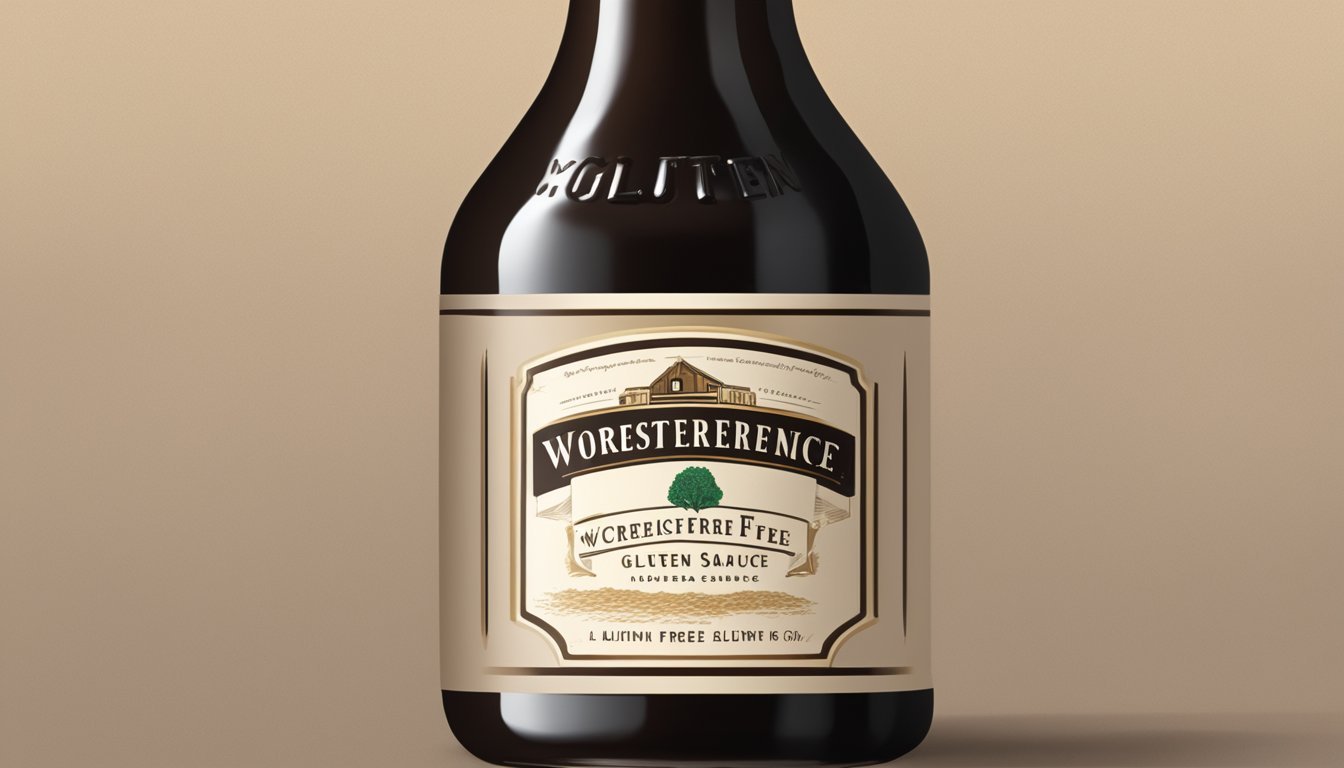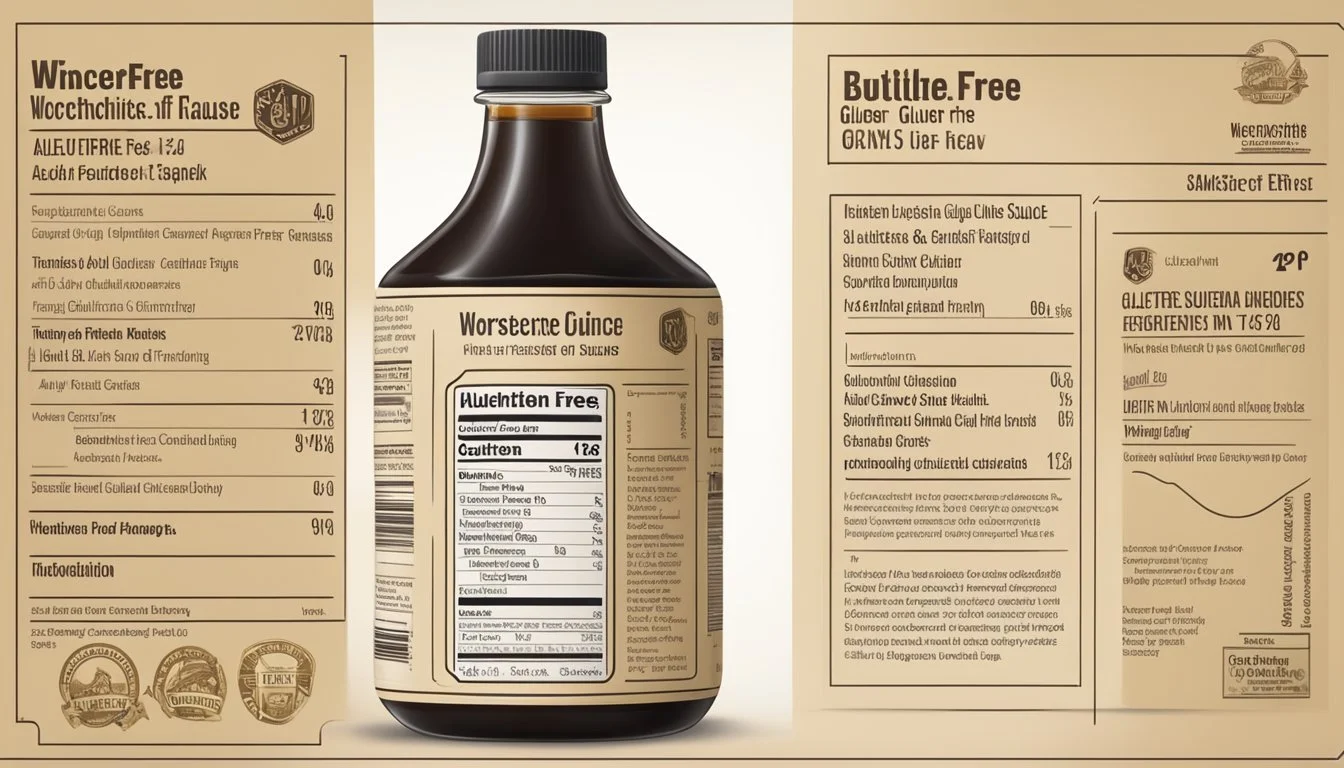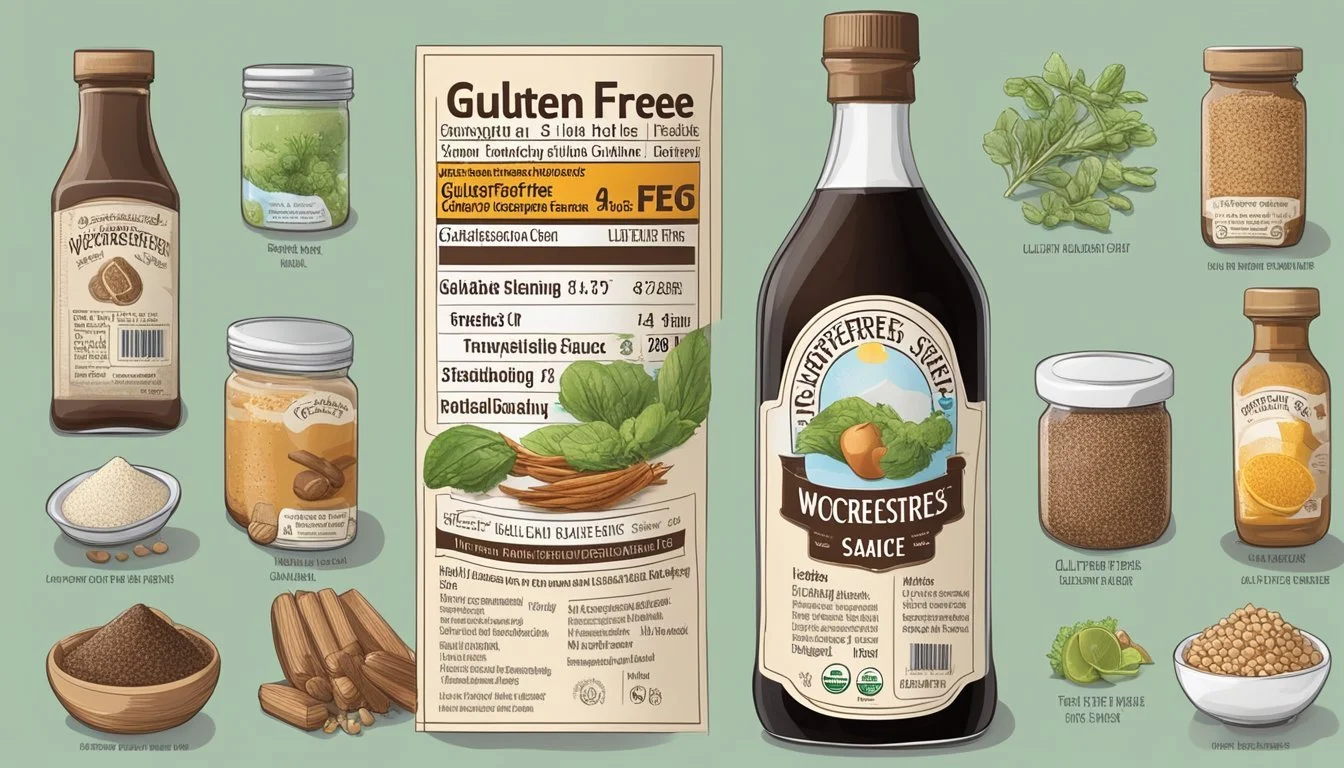Is Worcestershire Sauce Gluten-Free?
Unveiling the Facts on Common Brands and Ingredients
Worcestershire sauce is a fermented condiment created in the city of Worcester in Worcestershire, England in the 19th century. With its complex mixture of vinegar, molasses, anchovies, (What wine goes well with anchovies?) garlic, tamarind extract, and various seasonings, it imparts a savory umami flavor to dishes. Traditionally, the original Worcestershire sauce recipe includes barley malt vinegar, which contains gluten, a protein that can trigger health issues for individuals with celiac disease or gluten sensitivity.
For those following a gluten-free diet, the challenge with Worcestershire sauce arises from its traditional inclusion of barley malt vinegar. However, today, a variety of brands create gluten-free options by substituting the barley malt vinegar with vinegars made from gluten-free sources. Brands such as The Wizard's create both regular and gluten-free versions, taking care to provide an option for the gluten-sensitive consumers. In the United States, Lea & Perrins Worcestershire Sauce is made with distilled white vinegar as opposed to malt vinegar, making it a safe choice for those avoiding gluten.
The importance of carefully reading labels cannot be overstated, as not all products labeled as Worcestershire sauce are gluten-free. It is critical for consumers to look for clear labeling or certification indicating the absence of gluten. Luckily, the market has responded to consumer needs, and several gluten-free Worcestershire sauce alternatives are available, ensuring that the distinct taste of this beloved sauce remains accessible to all, including individuals who maintain a gluten-free diet.
Understanding Worcestershire Sauce
Worcestershire sauce, a complex condiment, is a blend of savory, sweet, and tangy ingredients that vary depending on the brand and recipe. The inclusion of gluten depends largely on specific components such as vinegar and flavorings.
Origins and Traditional Ingredients
Worcestershire sauce originated in the city of Worcester, England during the 19th century. The original Worcestershire sauce typically includes:
Vinegar: Provides tartness and acts as a preservative.
Molasses and Sugar: Adds sweetness.
Tamarind: Contributes to a unique sour flavor.
Anchovies: Imparts a savory, umami taste.
Garlic and Salt: Enhances flavor.
Spices: Varies by recipe but can include cloves, celery seed, and others.
Gluten-Containing Ingredients in Worcestershire Sauce
Gluten in Worcestershire sauce traditionally comes from:
Malt Vinegar: Derived from barley, a gluten-containing grain.
Soy Sauce: Some variants use soy sauce, which can include wheat, another source of gluten.
The presence of these ingredients makes it necessary for those on a gluten-free diet to carefully scrutinize labels.
Comparing Traditional and Gluten-Free Variants
When comparing traditional worcestershire sauce with gluten-free Worcestershire sauce, the main difference lies in the replacement of gluten-yielding ingredients. For instance:
Gluten-free Vinegar: Distilled white vinegar or gluten-free soy sauce often replaces malt vinegar.
Certification: Recipes are adapted to meet gluten-free standards of containing less than 20 parts per million (ppm) of gluten.
While many variants now opt for gluten-free ingredients, it is essential to check for a gluten-free label to ensure compliance with dietary restrictions.
Identifying Gluten-Free Options
When searching for gluten-free Worcestershire sauce, consumers should be aware of labeling, certifications, and the differing ingredients used by various brands. It is also important to consider additional dietary restrictions, such as vegan requirements.
Label Reading and Understanding Certifications
Careful inspection of product labels is essential for those adhering to a gluten-free diet. Gluten-free products in the US must meet FDA standards, which require that the food either contains no gluten-containing ingredients or has less than 20 parts per million of gluten. Certifications such as the Certified Gluten-Free label provide additional assurance. The brands Lea & Perrins and French's Worcestershire Sauce are identified as gluten-free according to their labels. However, consumers should still check for the most current labeling on the product.
Differences Among Gluten-Free Brands
Gluten-free Worcestershire sauce brands vary in their ingredients and flavor profiles. Some brands like Wan Ja Shan manufacture an organic and vegan Worcestershire sauce, while Lea & Perrins, a more popular brand, contains anchovy and is not vegan but is labeled gluten-free. Consumers may find differences in the umami flavor unique to each brand due to ingredient variations. Prices also vary, with some affordable options available in stores including Kroger, Whole Foods, and Publix.
Special Consideration for Other Dietary Restrictions
When selecting a gluten-free Worcestershire sauce, individuals with other dietary restrictions such as veganism should be vigilant. Most Worcestershire sauces typically contain anchovies, but brands like The Wizard's create a sauce suited for both vegans and those requiring gluten-free products. These special varieties forego the traditional anchovy base, providing an animal-free umami flavor. They can be typically found labeled as both vegan and gluten-free, which is beneficial for those with multiple dietary considerations.
Incorporating Worcestershire Sauce into a Gluten-Free Diet
Gluten-free Worcestershire sauce is a versatile condiment that can be safely incorporated into various recipes to enhance flavor profiles with its umami, savory, sweet, and tangy notes.
Safe Usage in Recipes
When incorporating gluten-free Worcestershire sauce into a gluten-free diet, one must ensure that the product is explicitly labeled as gluten-free. This sauce can elevate the taste of stews, soups, and marinades. It also serves as a critical ingredient in Caesar salad dressing and can be used to add depth to Bloody Marys. To safely use gluten-free Worcestershire sauce in recipes, individuals should:
Verify labels: Look for certification or manufacturer guarantees that the Worcestershire sauce is gluten-free.
Avoid cross-contamination: If preparing dishes for those with gluten intolerance, ensure there is no cross-contamination from gluten-containing products.
DIY Gluten-Free Worcestershire Sauce
For those who prefer homemade options, creating a homemade gluten-free Worcestershire sauce is straightforward. Here's a basic recipe:
Ingredients:
1 cup apple cider vinegar
2 tbsp water
2 tbsp soy sauce (gluten-free)
1 tbsp brown sugar
1/4 tsp ground ginger
1/4 tsp mustard powder
1/4 tsp onion powder
1/4 tsp garlic powder
A pinch of cinnamon and pepper
Method:
Combine all ingredients in a pot and bring to a boil.
Reduce heat and simmer until mixture is reduced by one-third, ensuring sugar is fully dissolved.
Cool and store in glass containers with lids.
Unique Pairings and Flavor Enhancements
Gluten-free Worcestershire sauce is not limited to traditional dishes; it can be an innovative addition to modern and creative recipes, offering unique pairings and flavor enhancements. Consider these culinary ideas:
Meatloaf: Incorporate sauce into the mixture for a moist and flavorful meatloaf.
Caesar Salad: Use in the dressing for a gluten-free Caesar salad, adding a punch of flavor.
Umami Flavoring: Add a dash to vegetarian dishes (What wine goes well with vegetarian dishes?) to introduce umami without meat.
Marinade: As a marinade base, it tenderizes meat while infusing complex flavors.
Shopping for Worcestershire Sauce
When looking for gluten-free Worcestershire sauce, consumers must carefully check labels for ingredients that contain gluten, such as malt vinegar or soy sauce. Certain brands have been verified as gluten-free and are safe for individuals with celiac disease or gluten sensitivity.
Locating Gluten-Free Worcestershire Sauce at Stores
Gluten-free Worcestershire sauce can be found in the condiment aisle of most grocery stores alongside traditional versions. Health food stores like Whole Foods often carry a selection of gluten-free options. Nationwide chains such as Kroger may stock gluten-free alternatives. For a hassle-free shopping experience, online marketplaces like Amazon offer a wide range of brands and deliver directly to your door.
Whole Foods: Known for a range of gluten-free products, including Worcestershire sauce.
Kroger: Look in the condiment section for gluten-free labels.
Amazon: Offers a convenient option for purchasing a variety of gluten-free Worcestershire sauces.
Recommended Gluten-Free Worcestershire Sauce Brands
Some reputable brands produce Worcestershire sauces that are specifically labelled as gluten-free. This takes the guesswork out of shopping for consumers following a strict gluten-free diet. Among these brands:
The Wizard's: Offers both vegan and gluten-free options. Look specifically for the gluten-free variant.
Wan Ja Shan: This brand handcrafts organic gluten-free Worcestershire sauces.
French's Worcestershire Sauce: Widely available and clearly labelled as gluten-free.
Lea & Perrins Original (U.S. version): The U.S. version is gluten-free, unlike its U.K. counterpart.
Heinz: Well-known for ketchup, also offers a selection of condiments that includes gluten-free products.
The Spice Lab: May offer gourmet gluten-free options to consider.
Here is a comparison table to help identify gluten-free Worcestershire sauce brands:
Brand Gluten-Free Variant Available Notes The Wizard's Yes Vegan and gluten-free varieties are available. Wan Ja Shan Yes Organic and gluten-free sauce made in New York. French's Yes Gluten-free Worcestershire sauce, accessible at many stores. Lea & Perrins (U.S.) Yes The U.S.-produced sauce is safe for a gluten-free diet. Heinz Conditional Check labels as Heinz offers a variety of condiments. The Spice Lab Conditional Luxury or specialty brands may provide gluten-free sauces.
Consumers are encouraged to always read the label to confirm that the product is gluten-free, as formulations may change.
FAQs About Worcestershire Sauce and Gluten
In navigating the complexities of Worcestershire sauce and its gluten content, consumers often grapple with deciphering labels, understanding ingredients, and comparing it to similar condiments. This section provides straightforward answers to common questions, clarifying the presence of gluten in Worcestershire sauce and what to look for when adhering to a gluten-free diet.
Common Questions Regarding Gluten Content
Many inquire whether Worcestershire sauce is gluten-free. The answer hinges on the specific brand and the ingredients used. Traditional recipes may include barley malt vinegar, a source of gluten, rendering the sauce unsuitable for those with celiac disease or gluten sensitivity. Those on a gluten-free diet should diligently check for labels explicitly stating "gluten-free," indicating the product contains less than 20 parts per million (ppm) of gluten.
Understanding the Labeling and Ingredient Substitutions
It's crucial to understand the labeling on Worcestershire sauce to ensure it aligns with a gluten-free diet. The U.S. Food and Drug Administration mandates that products labeled as "gluten-free" must meet strict standards. Here's a brief list of several common ingredients found in gluten-free versions of Worcestershire sauce:
Vinegar: Gluten-free Worcestershire sauce may use apple cider vinegar or distilled white vinegar instead of malt vinegar.
Tamari: A gluten-free alternative to soy sauce, tamari is sometimes used to maintain the sauce's umami flavor without the gluten.
When selecting a Worcestershire sauce, verify these substitution ingredients are present and that barley malt vinegar is absent.
The Difference Between Worcestershire Sauce and Soy Sauce
Worcestershire sauce and soy sauce are both rich in umami but differ significantly in ingredients and gluten content. Worcestershire sauce typically contains vinegar and may have gluten from sources like barley malt vinegar. In contrast, soy sauce is derived from soybeans, wheat, salt, and fermenting agents, although gluten-free soy sauce variants, such as tamari, are available for those avoiding gluten. Notably, gluten-free Worcestershire sauce often incorporates gluten-free soy sauce or tamari to maintain its distinct taste without the gluten, while fish sauce can be a gluten-free alternative with a similar savory profile.
Additional Tips and Considerations
When selecting a gluten-free Worcestershire sauce, one should be mindful not only of the ingredients but also of the storage, pairing, and appreciation of the sauce's complex flavor profile. This section will cover essential advice for maximizing the shelf life and taste experience of Worcestershire sauce.
Proper Storage and Handling
To maintain the quality of gluten-free Worcestershire sauce, it should be stored in a cool, dry place away from direct sunlight. After opening, they recommend keeping the sauce refrigerated to preserve its flavor and extend its shelf life. One should always use clean utensils when handling the sauce to prevent contamination. The typical shelf life for an opened bottle, when stored correctly, ranges from 18 months to 3 years.
Pairing with Other Condiments
Gluten-free Worcestershire sauce complements a variety of condiments. When combined with ketchup, it can enhance the zest of homemade cocktail sauces. Mixing it with mustard or hot sauce adds an extra dimension to marinades and dressings. However, one should ensure that these pairings align with dietary restrictions, particularly concerning gluten content. Common pairings include:
Ketchup for burgers and fries.
Mustard in dressings or as a rub for meats like chicken or pork.
Chili pepper extract in barbecue sauces for a smoky and spicy kick.
Exploring the Nuances of Flavor
Not all gluten-free Worcestershire sauces are created equal, and their flavor profiles can vary significantly. Traditional Worcestershire sauce often contains malt vinegar derived from barley, which is not gluten-free. Gluten-free versions might replace this with balsamic vinegar or a blend of vinegar from rice and other sources. Ingredients such as tamarind, cloves, garlic, onion, and celery seed contribute to the umami-rich, tangy character of the sauce. When experimenting with gluten-free Worcestershire sauce in recipes, consider its interaction with other bold flavors, such as:
Clove and garlic for an aromatic and spicy warmth in soups and stews.
Brown sugar or molasses to balance acidity and add sweetness to marinades.
Ground ginger or mustard to elevate the piquant nature of the sauce in dressings.
Conclusion
When assessing whether Worcestershire sauce is gluten-free, one must understand that not all brands are created equal. The gluten content in Worcestershire sauce mainly hinges on the type of vinegar used and the facility where it is produced.
Gluten-Free Brands:
The Wizard's Gluten-Free Vegan Worcestershire Sauce
Wan Ja Shan Organic Gluten-Free Worcestershire Sauce
French's Worcestershire Sauce (U.S. version)
Lea & Perrins Original (U.S. version)
These brands have been verified as gluten-free and safe for those with celiac disease. They typically use white vinegar instead of barley malt vinegar, which contains gluten. Additionally, the risk of cross-contamination is minimized as these brands follow strict gluten-free production protocols.
Key Ingredients:
Vinegar (gluten-free sources like white vinegar)
Molasses and sugar
Shallots or garlic
Spices (e.g., cloves, celery seed)
In some cases, the original recipe, which might include malt vinegar from barley, is altered to cater to the gluten-free market. Reading the ingredient label is critical for individuals with gluten sensitivities. They must look for a gluten-free label or certification to ensure that the product is indeed free from gluten and safe for consumption.
Consumers should also be aware of the possibility of Worcestershire sauce containing fish, as some variants include fermented anchovies, which can be an allergen for some individuals. For a homemade alternative, there are recipes that allow for the creation of a gluten-free version, controlling the ingredients to one's dietary needs.
In summary, many Worcestershire sauces can be enjoyed by those on a gluten-free diet, but vigilance in selecting the right brand and inspecting labels is essential.






